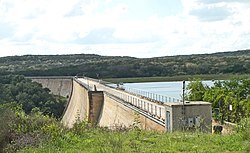|
Medina Dam
The Medina Dam is a hollow-masonry type dam built in 1911 and 1912 by the Medina Irrigation Company in what became Mico, Texas, USA. Medina Lake extends north of it in northeastern Medina County and southeastern Bandera County. The dam and irrigation project was designed and financed by Dr. Frederick Stark Pearson, an American engineer, with extensive British financial backing. The construction took over 1500 men two years to build while working 24 hours a day. They were mostly skilled Mexican workers with experience building other dams for Pearson. They received two dollars for a day's work, which were good wages for the time.[2][3] Pearson's Medina Irrigation Company (MICO) built a camp to house the workers and their families; the company town was first called MICO after its acronym. The community is now known as Mico, Texas. When the dam was completed in 1913, it was the largest hydraulic engineering project west of the Mississippi River and the fourth-largest dam in the US.[4] It is listed on the National Register of Historic Places for its significance as an infrastructure project and its contributions to economic development of the county. Author of Ripples from Medina Lake, Rev. Cyril M. Kuehne claims a total of 70 lives were taken during the dam's construction, however, he only managed to locate 27 death certificates. Dr. Oscar B. Taylor, dentist of near-by settlement Hondo, Texas, was quoted by Kuehne as saying "sixty-six [unmarked] graves" were counted at a cemetery 3 miles away.[5] The dam contains over 292,000 cubic yards (223,000 m³) of concrete and measures 164 feet high by 128 feet (39 m) wide at the base by 1,580 feet (482 m) long. It is 25 feet (8 m) wide at the top, which is 1076.2 feet (328 m) above sea level, and the spillway is 1,064.2 feet (324 m) above sea level.[6] The dam provides irrigation to over 34,000 acres (138 km²) to Blackland Prairie farmlands below the Balcones Escarpment around Castroville, Texas, and also supplies water to the Medina River Ultrafiltration Water Treatment Plant owned and operated by the San Antonio Water System.[7] The reservoir behind the dam is called Medina Lake and is a major recreation area. It discharges into the Medina River, which also contains a diversion dam four miles downstream. The dam was featured in the 1919 serial The Masked Rider.[8] Medina Dam was once a publicly accessible, one-lane roadway that connected to County Road 260. In 1980, vehicle traffic was closed and rerouted to a new road known as County Road 264; although temporary use of the dam as a road continued in 1990.[9] Historical State Markers on the DamLocated on the dam are three state-placed historical markers. These markers are currently inaccessible to the public after foot traffic was disallowed following the September 11 attacks in response to terrorism concerns. [10] 1936 Mountain Valley markerThe earliest of the three markers is a 1936 state marker that acknowledges the previous Mormon settlement, Mountain Valley that was built in 1854 and was destroyed in 1913 during construction of the dam.[11] The Mormon settlement Mountain Valley is now located underneath Medina Lake.[9]
1978 Texas Historical Commission MarkerThe next is a marker placed in 1978 by the Texas Historical Commission that designated the dam as a state historical landmark.[13]
1991 Texas Historic Civil Engineering MarkerPlaced in 1991, a marker declared the dam a Texas Historic Civil Engineering Landmark.[9] Reopening of the DamThe Medina Lake Preservation Society is undertaking efforts to get the dam reopened to the public, or to at least have the historical markers moved so people can see them.[15] See also
References
Further reading
External links
|
||||||||||||||||||||||||||||||||
Portal di Ensiklopedia Dunia





